New Mexico’s diverse landscapes, from high mountain forests to desert canyons and open grasslands, provide a home to an impressive variety of squirrels. Each species has its own unique adaptations, making the state an excellent place for wildlife enthusiasts to observe them in their natural habitats.
From the bold and widespread Rock Squirrel to the striking tassel-eared Abert’s Squirrel and the rare Arizona Gray Squirrel, New Mexico hosts both common and elusive species. Ground-dwelling squirrels and prairie dogs thrive in grasslands and deserts, while Red Squirrels and Southern Flying Squirrels bring excitement to forested areas.
This guide will introduce you to 10 types of squirrels found in New Mexico, with detailed descriptions, pictures, and identification tips. You’ll also learn about their habitats, behaviors, diets, and the best places to see them across the state.
Different Types of Squirrels Found in New Mexico
Rock Squirrel (Otospermophilus variegatus)
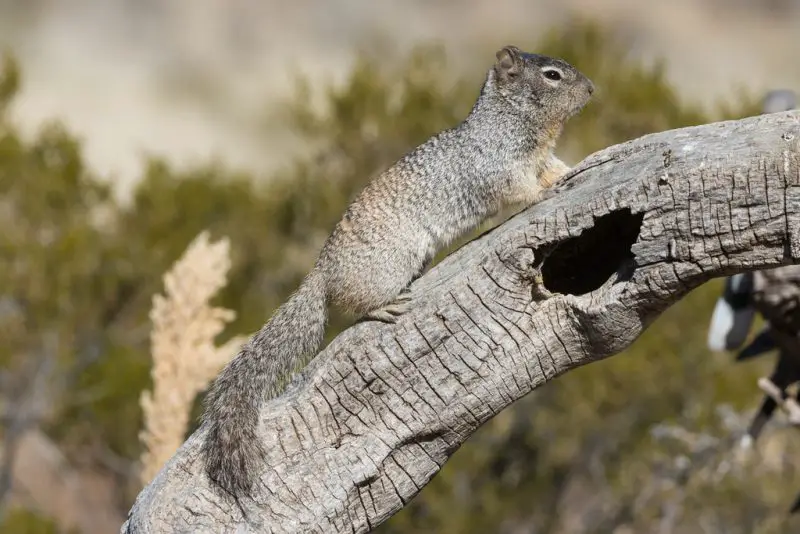
The Rock Squirrel is one of the most widespread squirrels in New Mexico and is easily recognized by its large size and mottled gray-brown coat. Adults typically measure about 17 to 21 inches long, including their bushy tails, which are flecked with white hairs. Their bodies are robust, with short legs and strong claws adapted for digging burrows in rocky terrain. Their overall appearance helps them blend into the desert and canyon landscapes they inhabit.
These squirrels are highly adaptable and often make their homes in rocky outcrops, desert scrublands, and even urban areas. They prefer to dig elaborate burrow systems, which they use for shelter, raising young, and escaping predators. Rock Squirrels are primarily diurnal and can often be spotted basking on rocks in the morning sun. During hot afternoons, they retreat to the safety of their burrows to avoid the desert heat.
Their diet is diverse, consisting of seeds, nuts, fruits, roots, and occasionally insects. They are well known for caching food in their burrows to prepare for leaner seasons. Interestingly, they can also climb trees, though they spend most of their time on the ground. In New Mexico, Rock Squirrels are common across desert canyons, mountain foothills, and rural communities where food is abundant.
A fun fact about Rock Squirrels is their boldness around humans. In some areas of New Mexico’s national parks, they are notorious for approaching visitors in search of snacks. Despite their seemingly tame behavior, they can become aggressive if cornered and should not be hand-fed. Their curious nature makes them both entertaining and troublesome in campgrounds.
Abert’s Squirrel (Sciurus aberti)

Abert’s Squirrel, also known as the tassel-eared squirrel, is one of New Mexico’s most striking tree squirrels. It is distinguished by its long ear tufts, which are most prominent in winter, giving it a very unique look compared to other squirrels. Its fur is typically gray with a reddish back and a pure white belly, complemented by a long, fluffy tail edged in white. Adults can measure around 18 to 23 inches long, with the tail making up about half of the total length.
This squirrel is strongly associated with ponderosa pine forests, which dominate many mountainous regions of northern and central New Mexico. They are arboreal by nature and rarely venture far from trees, depending heavily on them for both food and shelter. Abert’s Squirrels construct dreys, or leafy nests, high in the trees, though they may also use tree cavities when available. Their presence is often a good indicator of healthy ponderosa pine ecosystems.
Their diet is specialized compared to other squirrels. They primarily feed on ponderosa pine seeds, bark, buds, and twigs. In addition, they consume fungi, particularly truffles, which they locate underground with their keen sense of smell. By eating fungi and spreading spores, Abert’s Squirrels actually help maintain the health of pine forests through natural symbiosis.
A fun fact about Abert’s Squirrels is that their survival is almost completely tied to ponderosa pines. Studies have shown that they rarely thrive in other types of forests. In winter, when food is scarce, they are known to strip the bark off branches to access the nutritious inner tissue. Their dramatic ear tufts and forest-bound lifestyle make them one of New Mexico’s most charismatic squirrels.
Arizona Gray Squirrel (Sciurus arizonensis)

The Arizona Gray Squirrel is less common in New Mexico and has a more restricted range compared to other tree squirrels. It is medium-sized, measuring about 17 to 20 inches long, with a sleek gray coat and a broad, bushy tail. Its fur tends to be uniform gray with subtle white underparts, lacking the reddish or black tones often seen in other squirrel species. Its appearance is very similar to the Eastern Gray Squirrel, but its distribution is limited to the southwestern U.S. and northern Mexico.
In New Mexico, this squirrel is found only in certain southern and southwestern mountain ranges, particularly in riparian habitats with oaks, walnuts, and sycamores. It is strongly associated with woodlands that provide both cover and a variety of nut-bearing trees. Because its habitat is fragmented, the Arizona Gray Squirrel is considered a rare and localized species within the state.
Their diet consists mainly of acorns, walnuts, pecans, and other tree nuts, though they will also eat fruits, seeds, and fungi. Unlike Rock Squirrels, which are mostly ground-dwelling, Arizona Gray Squirrels are highly arboreal and spend much of their time in tree canopies. They build leafy nests high above the ground, offering protection from predators such as hawks and snakes.
A fun fact about this squirrel is that it plays a key role in seed dispersal in the oak and walnut forests of New Mexico. By burying acorns and forgetting some of them, these squirrels inadvertently help regenerate trees. Their rarity in New Mexico makes sightings exciting for wildlife enthusiasts and birdwatchers exploring riparian zones.
Fox Squirrel (Sciurus niger)
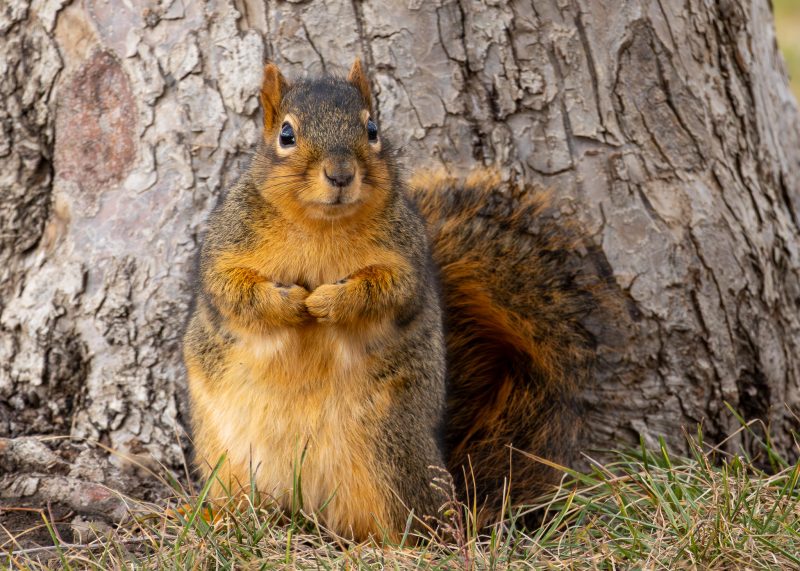
The Fox Squirrel is the largest tree squirrel in North America and can occasionally be found in New Mexico, particularly in areas where they have been introduced. Adults typically measure 18 to 27 inches long, with a weight ranging between 1.5 and 2.5 pounds. Their fur color varies widely, from reddish-brown to gray, often with a mix of rust-colored tones on the belly and a long, bushy tail with black edges. Their large size and bright coloration make them fairly easy to distinguish from other squirrels.
In New Mexico, Fox Squirrels are more commonly seen in riparian corridors, farmlands, and urban parks, where they adapt readily to human-altered landscapes. They build large leafy nests in tall trees, but they are equally comfortable foraging on the ground. Unlike Abert’s Squirrels, which prefer pine forests, Fox Squirrels thrive in mixed woodlands with hardwood trees like pecans, walnuts, and oaks.
Their diet is broad and includes acorns, pecans, corn, fruits, buds, and insects. They are especially well-known for raiding bird feeders and agricultural crops, which sometimes puts them at odds with farmers. Like many squirrels, they bury nuts in the ground, contributing to forest regeneration. Their opportunistic feeding habits have allowed them to expand their range in many parts of the United States.
A fun fact about Fox Squirrels is their ability to adapt to open habitats. Unlike most tree squirrels, they are less reliant on dense forests and can thrive in semi-open landscapes. In New Mexico, their presence is often tied to human activity, making them a common sight in towns and farmlands where food sources are plentiful.
Gray Fox Squirrel (Sciurus carolinensis)

The Eastern Gray Squirrel, sometimes called the Gray Fox Squirrel in local references, is less common in New Mexico but has small, introduced populations in urban parks and residential areas. It is medium-sized, measuring 16 to 20 inches long and weighing about 1 to 1.5 pounds. Its coat is predominantly gray with a white belly and a large, fluffy tail with silver-tipped hairs. This squirrel is one of the most familiar species in the eastern United States, but it occurs in much smaller numbers in New Mexico.
Its preferred habitats are hardwood forests, parks, and suburban areas where oak and walnut trees are abundant. In New Mexico, it is mostly found in localized populations around human settlements, where introduced individuals have established. Unlike the more specialized Abert’s Squirrel, the Eastern Gray Squirrel is highly adaptable to a variety of environments, provided that trees are available for nesting and food.
Their diet is varied, consisting of acorns, walnuts, seeds, berries, and fungi. They are excellent climbers and spend most of their time in trees, though they also forage on the ground. Known for their caching behavior, Gray Squirrels bury nuts in scattered locations, later relocating them using spatial memory and scent. This behavior makes them one of the key contributors to seed dispersal in their habitats.
A fun fact about the Eastern Gray Squirrel in New Mexico is that it represents an introduced species outside its native range. While they are considered common pests in the eastern U.S., in New Mexico they remain relatively rare, which makes spotting them more unusual. Their playful nature and quick movements often capture the attention of park visitors and backyard observers.
Red Squirrel (Tamiasciurus hudsonicus)
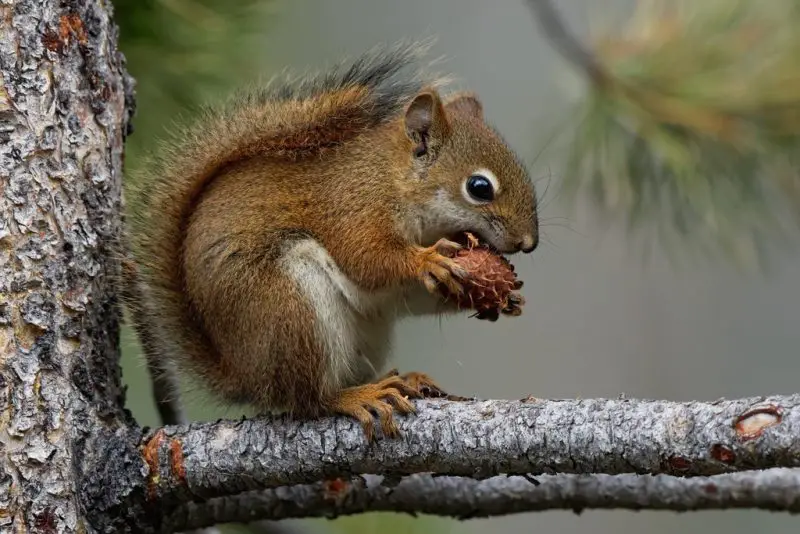
The Red Squirrel is a small but feisty species found in New Mexico’s higher mountain forests. Adults typically measure 11 to 14 inches in length, with a weight of about 7 to 9 ounces, making them noticeably smaller than Abert’s or Fox Squirrels. Their fur is reddish-brown on the back with a white belly and a fluffy tail that often has a darker tip. In winter, their coat becomes thicker and may take on a more grayish hue, helping them withstand cold mountain conditions.
These squirrels thrive in coniferous forests, particularly spruce, fir, and pine woodlands in northern New Mexico. Unlike other squirrels that may live in leafy nests, Red Squirrels often occupy tree cavities or build compact nests of moss and shredded bark. They are highly territorial, defending their feeding grounds with loud chattering calls. Their energetic and aggressive nature makes them easy to notice despite their small size.
Red Squirrels are known for their food storage behavior, particularly creating large piles of cone scales called “middens.” They feed primarily on conifer seeds but will also eat mushrooms, berries, and occasionally bird eggs. Their habit of collecting and storing food allows them to survive harsh mountain winters. This squirrel’s role in dispersing fungi also benefits forest health.
A fun fact about Red Squirrels is their habit of drying mushrooms on tree branches. They hang fungi in the sun to preserve them for later consumption, a behavior unique among North American squirrels. In New Mexico’s mountains, hikers may stumble upon these mushroom “pantries,” a sure sign of Red Squirrel activity.
Southern Flying Squirrel (Glaucomys volans)
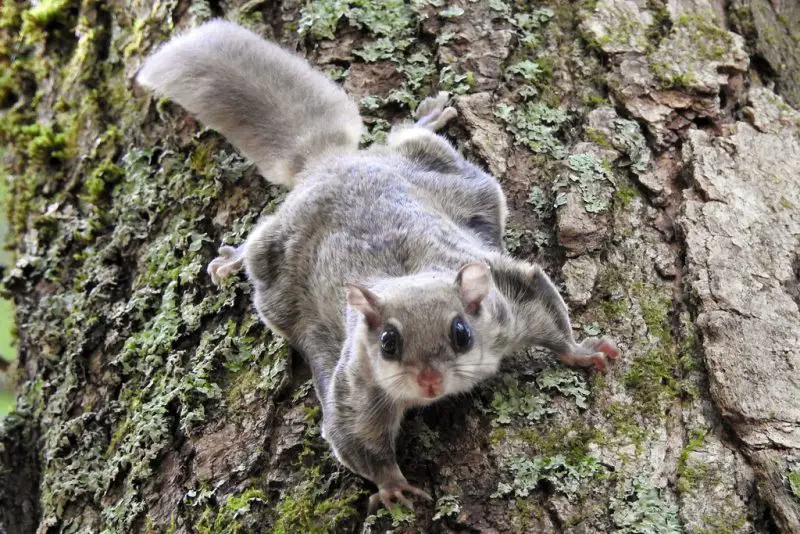
The Southern Flying Squirrel is one of the most secretive squirrels in New Mexico, known for its nocturnal habits and ability to glide between trees. Adults are small, measuring 8 to 10 inches in length, with large dark eyes adapted for night vision and soft grayish-brown fur with a creamy white belly. The most distinctive feature is the patagium, a thin flap of skin stretching between the front and back legs, which allows them to glide through the forest canopy.
In New Mexico, this species is found only in limited areas in the eastern part of the state, where hardwood forests provide the cover and food they need. Because they are nocturnal, they are rarely seen by casual observers. They typically nest in tree cavities, abandoned woodpecker holes, or constructed leafy nests. During winter, multiple individuals often huddle together for warmth in a shared den.
Their diet consists of nuts, seeds, fruits, and fungi, but they also eat insects and even small birds’ eggs. Unlike most diurnal squirrels, Southern Flying Squirrels rely heavily on night activity, gliding silently between trees in search of food. Their gliding ability helps them avoid ground predators and efficiently travel between feeding areas.
A fun fact about Southern Flying Squirrels is that they can glide over 150 feet in a single leap. They use their tails as rudders to steer during flight. In New Mexico, spotting one is a rare and exciting event for wildlife enthusiasts, as their elusive habits and restricted range make them one of the state’s most mysterious squirrels.
Thirteen-lined Ground Squirrel (Ictidomys tridecemlineatus)
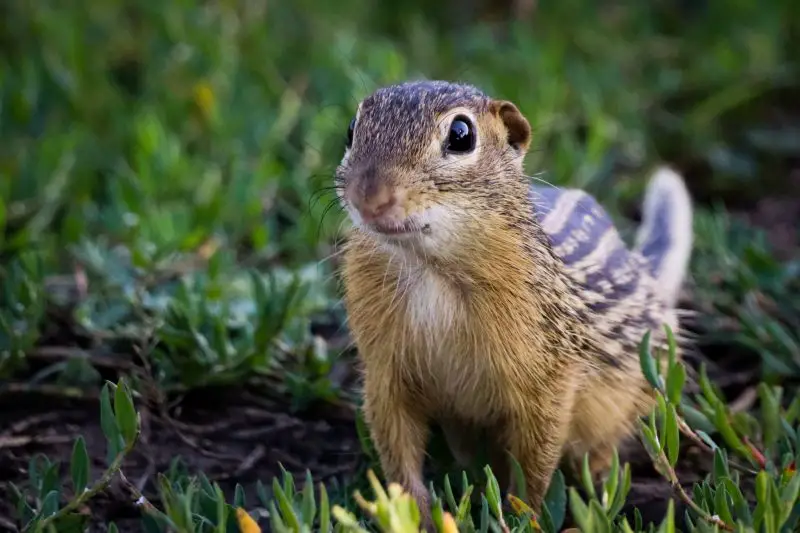
The Thirteen-lined Ground Squirrel is a small, slender species that is easy to recognize thanks to its striking coat pattern. Its fur is brown with thirteen alternating white and dark stripes running along its back and sides, creating a bold and distinctive look. Adults measure 7 to 12 inches long and weigh about 5 to 9 ounces. Its streamlined body and short tail are well-suited for life on the ground.
This species prefers open grasslands, prairies, and agricultural fields, and it can be found in eastern New Mexico where such habitats are abundant. They dig burrows in the soil, which provide shelter, storage, and a place to hibernate during the winter months. Because they are highly adapted to open areas, they are less commonly seen in forested regions.
Their diet includes seeds, grasses, insects, and even small vertebrates such as young mice or bird nestlings. Unlike tree squirrels, these ground squirrels are omnivorous and opportunistic feeders. They spend much of their active time in summer foraging and building up fat reserves to survive hibernation.
A fun fact about Thirteen-lined Ground Squirrels is their incredible hibernation ability. In winter, their body temperature and heart rate drop dramatically, allowing them to remain underground for months with minimal energy use. Their striped pattern not only serves as camouflage in grassy fields but has also earned them the nickname “striped gopher” in some areas of New Mexico.
Round-tailed Ground Squirrel (Xerospermophilus tereticaudus)
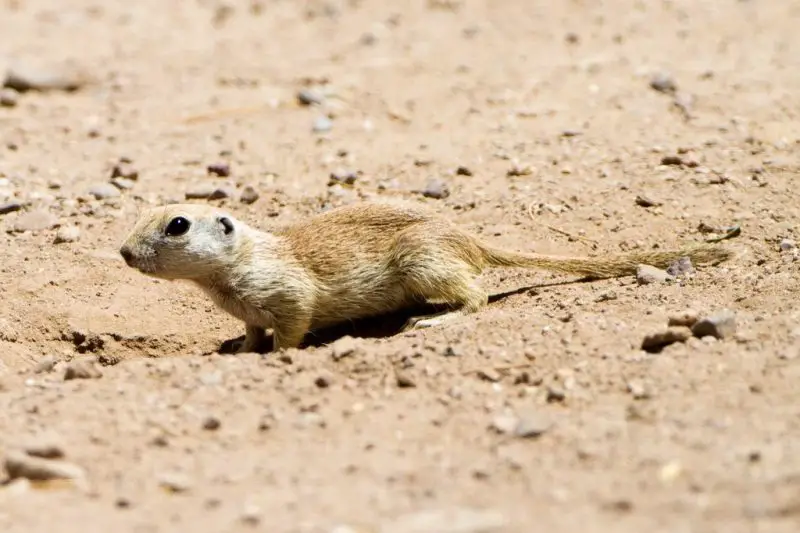
The Round-tailed Ground Squirrel is a desert specialist, well-adapted to the hot and arid environments of southern New Mexico. It is small, measuring 8 to 10 inches long, with light sandy-brown fur that blends perfectly with desert soils. Unlike many other ground squirrels, it has a thin, rounded tail covered in short hair, which is where its name comes from. Its large eyes and small ears give it a delicate, almost mouse-like appearance.
This species inhabits desert flats, sandy washes, and scrublands where vegetation is sparse. They live in burrow systems dug into the soil, which provide protection from extreme heat and predators. Round-tailed Ground Squirrels are active during the day, but they are most commonly seen in the cooler mornings before retreating to their burrows in the afternoon sun.
Their diet is mainly herbivorous, consisting of seeds, grasses, cactus pads, and desert wildflowers. They can also feed on insects when available. Remarkably, they are able to survive long periods without direct water intake, deriving necessary moisture from their plant-based diet. In drought conditions, they become less active to conserve energy and water.
A fun fact about Round-tailed Ground Squirrels is their ability to communicate danger with high-pitched alarm calls. When a predator is nearby, one squirrel will whistle to alert the colony, sending others scurrying into their burrows. Their desert lifestyle and social behaviors make them fascinating residents of New Mexico’s arid landscapes.
Gunnison’s Prairie Dog (Cynomys gunnisoni)
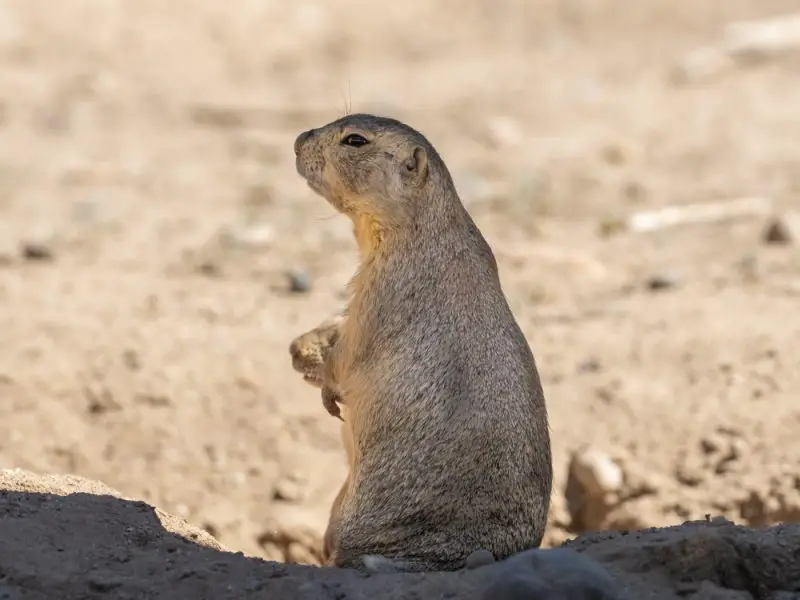
Gunnison’s Prairie Dog is a burrowing ground squirrel relative found in New Mexico’s grasslands and high desert regions. It is stocky, with a body length of 12 to 15 inches and weighing about 1.5 to 2.5 pounds. Its fur is yellowish to tan, blending well with the prairie soils, and it has a short, black-tipped tail. Their round heads, short ears, and expressive postures make them one of the most recognizable rodents in the state.
They live in large colonies called “towns,” where hundreds of individuals may share an interconnected system of burrows. These burrows provide shelter from predators, protection from extreme weather, and safe nesting areas. Gunnison’s Prairie Dogs are social animals and spend much of their time interacting, grooming, and “kissing” one another as a form of recognition.
Their diet is entirely plant-based, with grasses, herbs, roots, and seeds making up the majority of their food intake. As herbivores, they play an important ecological role by maintaining grassland health. Their grazing habits promote plant diversity, and their burrowing activity helps aerate the soil. In New Mexico, they are found in central and northern grasslands, often in valleys and plateaus.
A fun fact about Gunnison’s Prairie Dogs is their sophisticated communication system. They use a series of high-pitched calls that can describe not only the type of predator approaching but even its size and speed. Researchers consider their alarm calls one of the most complex forms of communication known among rodents. Watching them pop in and out of burrows is a favorite sight for many New Mexico visitors.
Best Time and Places to See Squirrels in New Mexico
The best time to observe squirrels in New Mexico depends on both the species and the habitat. Most squirrels are diurnal, meaning they are active during the day, with peak activity in the early morning and late afternoon. Rock Squirrels and ground squirrels are especially visible during spring and summer when they forage heavily before the heat of midday. In contrast, Red Squirrels and Abert’s Squirrels are more active year-round in the mountain forests, although they may be less visible during harsh winter storms. Flying squirrels, being nocturnal, are best spotted after dusk with the help of red light or night-vision equipment.
When it comes to locations, New Mexico’s diverse landscapes provide excellent opportunities. For mountain species like Abert’s Squirrel and Red Squirrel, the Sangre de Cristo Mountains, Jemez Mountains, and Sacramento Mountains are prime viewing spots, especially in ponderosa pine and spruce-fir forests. Rock Squirrels are common in canyons, desert foothills, and national parks such as Carlsbad Caverns and Bandelier. The Arizona Gray Squirrel is much harder to find, but it may be seen in riparian woodlands of the southwestern mountain ranges.
In grassland and desert regions, ground squirrels and prairie dogs dominate. Thirteen-lined Ground Squirrels can be observed in eastern prairies and agricultural fields, while Round-tailed Ground Squirrels thrive in southern deserts and sandy washes. Gunnison’s Prairie Dogs are best viewed in open colonies across northern New Mexico valleys and plateaus, where their social behavior is highly entertaining. Many of these areas are accessible through public lands and wildlife refuges.
Overall, spring and early summer provide the best conditions for observing the widest variety of squirrels in New Mexico, as food is plentiful and young squirrels emerge from their nests. For photographers and wildlife watchers, mornings offer the most activity combined with softer light. From desert canyons to alpine forests, New Mexico’s landscapes host an impressive diversity of squirrel species, each with unique behaviors that make them rewarding to watch.
FAQs about Squirrels in New Mexico
What types of squirrels live in New Mexico?
New Mexico is home to a wide variety of squirrels, including Rock Squirrels, Abert’s Squirrels, Arizona Gray Squirrels, Fox Squirrels, and Eastern Gray Squirrels. In addition, mountain forests host Red Squirrels, while the state’s grasslands and deserts support species such as Thirteen-lined Ground Squirrels, Round-tailed Ground Squirrels, and Gunnison’s Prairie Dogs. The Southern Flying Squirrel also occurs in small numbers in the eastern part of the state.
When is the best time to see squirrels in New Mexico?
The best time to observe squirrels is in the early morning and late afternoon, when most species are active and foraging. Spring and summer are particularly good seasons, as squirrels spend more time outside collecting food and caring for young. For nocturnal species like the Southern Flying Squirrel, nighttime observation is necessary.
Where can I see Abert’s Squirrels in New Mexico?
Abert’s Squirrels are strongly tied to ponderosa pine forests, which are common in northern and central mountain ranges such as the Sangre de Cristo Mountains, Jemez Mountains, and Sacramento Mountains. They are most often seen leaping between trees or foraging on the forest floor near pines.
Are Rock Squirrels dangerous to humans?
Rock Squirrels are bold and sometimes approach people in national parks and campgrounds. While they may look friendly, they can bite if provoked and should never be fed by hand. Feeding them can also encourage nuisance behavior, so it’s best to admire them from a distance.
Do squirrels hibernate in New Mexico?
Not all squirrels in New Mexico hibernate. Tree squirrels such as Abert’s, Rock, and Red Squirrels remain active throughout the year, although they may reduce activity during severe weather. Ground-dwelling species like the Thirteen-lined Ground Squirrel enter true hibernation, retreating into burrows and lowering their body temperature to survive the winter months.
What do squirrels in New Mexico eat?
Squirrels in New Mexico have diverse diets depending on the species. Tree squirrels primarily eat seeds, nuts, and fungi, while ground squirrels consume seeds, grasses, and insects. Some species, like Red Squirrels, store pine cones in large middens, while Round-tailed Ground Squirrels survive on desert plants and cactus pads.
Are there flying squirrels in New Mexico?
Yes, the Southern Flying Squirrel is present in small numbers in eastern New Mexico. They are nocturnal and secretive, making them difficult to spot. These squirrels glide between trees at night using a skin membrane called the patagium, which stretches between their legs.
What role do squirrels play in New Mexico’s ecosystems?
Squirrels are essential for forest and grassland ecosystems. By caching and burying nuts, they help regenerate trees. Ground squirrels and prairie dogs aerate the soil through their burrows, which also provide habitats for other wildlife. Their feeding habits promote plant diversity, while they themselves serve as prey for hawks, owls, coyotes, and snakes.






